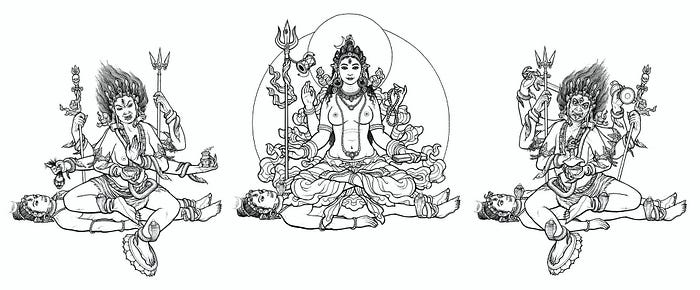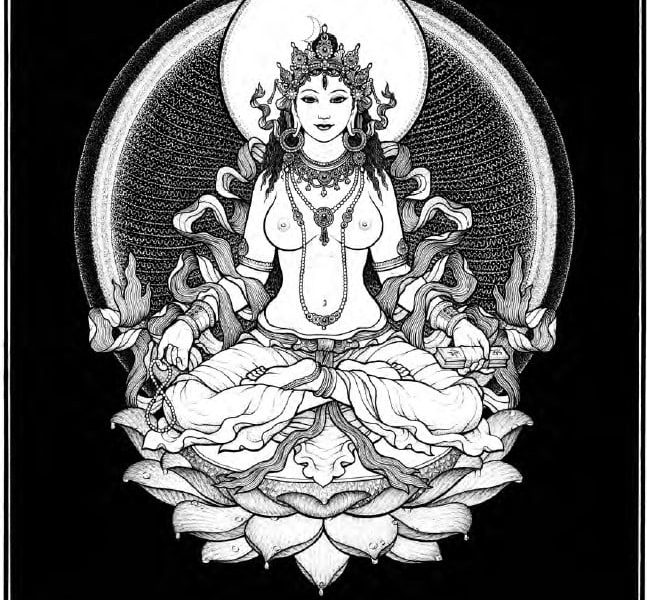
There is a resurgence of interest arising in traditional Tantra in large propelled by the work of scholar-practitioners such as Christopher Wallis and Christopher Tompkins, and informed by the publication of books like Tantra Illuminated and The Recognition Sutras.
This resurgence was possibly seeded by the stratospheric rise — and burnout — of Anusara Yoga. It was founded in 1997 and crashed spectacularly in 2012 with allegations of pension-stealing, witchcraft and adultery.
Part of Anusara’s legacy though was that it introduced many yogic practitioners to non-dual Tantrik philosophy for the first time.
Grounded in Non-Dual Tantrik philosophy, Anusara teaches us that everything in this world is an embodiment of Supreme Consciousness. The essence of the Supreme pulsates with pure awareness and pure bliss.~ Anusara Yoga Philosophy
My introduction to traditional Tantra came in 2010 when I completed my 200hr yoga teacher training with Shiva Rea. She had scholar-practitioner Christopher Tompkins guest teach the Tantrik portion of the Training every morning at 6 am. He’s a passionate, inspired and dedicated practitioner and academic and he brought the essence of Tantra alive in those two-hour lecture and practice sessions.
That was the beginning of my dedication to Tantrik practice — specially Ucchāra Practice.
So what IS traditional Tantra?
For this, we’ll turn to Christopher Wallis – note that this definition is specific to classical Tantra, which is defined by the survival of texts. Traditional Tantra has much older roots. He says:
“You may wonder what the phrase “classical Tantra“ refers to. It identifies the peak period of the Tantrik movement (800–1100 CE) and distinguishes our subject matter from the later Hindu Tantra and haṭha-yoga traditions (both 1100–1800), and also from modern American neo-Tantra (started around 1905 by Pierre Bernard). The classical Tantra that I treat in my book is associated with a specific religious tradition, the religion of Shiva & Shakti, commonly known as Shaivism. Shaivism was practiced all over what is now India, Nepal, Pakistan, Southeast Asia, and Indonesia, and was the dominant religion of India in the medieval period (600–1200). But there is also the important category of Buddhist Tantra; and many of the practices of Buddhist Tantra were directly adopted from the classical Śaiva Tantra.”
~ What is Tantra by Christopher Wallis
When I’m asked that question, I like to say that traditional Tantra is a systematic approach to awakening, liberation and enjoying your life.
It’s about seeing the world directly and clearly, without the filters and biases of beliefs and protection mechanisms. And it’s about the capacity and willingness to meet each moment fully — no matter how painful (or how pleasurable) it might be.
The three goals of traditional Tantra are:
- Awakening — to essence nature, or awareness, or Shiva nature, of the joy of being. These are all synonyms for the same thing — the process of shifting identification from the ‘story of me’, with all it’s thoughts, stories, ideas and feelings… to knowing oneself AS awareness.
- Liberation — from mind-creating suffering, from limitations, and from the limited sense of self.
- Enjoyment — of this material world.
Yes, traditional Tantra, unique amongst many spiritual traditions, includes our ability to enjoy and savour being alive as one of its goals. This goal is always sublimated to the other two goals — awakening and liberation — but it is also important. This is the path of embodied liberation — being free whilst still being in the body, and functioning as a human being in householder life. That means awakening while still being immersed in family, jobs and social responsibilities.
This particular focus — of embodied liberation in householder life — is what makes traditional Tantra such a potent lens today. It says that ordinary people can awaken, liberate and enjoy embodied liberation in this lifetime.
How?
By aligning View Teachings, Practices and Fruits — the alignment of these three things is what leads to embodied liberation.
Traditional Tantra View Teachings are ways to perceive the world that lead to awakening and liberation.
In The Essence of the Recognition Philosophy (Pratyabhijñā-hṛdaya), a 1000-year-old text written by Kṣhemarāja, the View Teachings are laid out systematically, sutra by sutra, before any practices are given.
Students must have the correct View before they attempt the practices. Otherwise, the practices are useless.
That’s why, despite the massive yogasana boom in the last decade or so, people aren’t waking up like popcorn.
You can do all the Downward Dogs you like, but if you haven’t received the correct View Teachings, it’s never going to lead to awakening. Or at least, it’s very, very, very, very unlikely. Yogasana without View Teachings really is just a physiological pursuit, not a spiritual pursuit.
The first Sutra of Pratyabhijñā-hṛdaya states:
“Awareness, free and independent, is the cause of the performance of everything.”
~ Translation by Christopher Wallis
Its author, Kṣhemarāja, then goes on to provide commentary, revealing that this sutra can be understood and examined in five different ways.
The contemplation and eventual understanding of this sutra is a View teaching. When a student ‘gets it’, their View of reality changes, and through that changed View, awakening and liberation become more possible.
This is a central Tantrik teaching — that everything we perceive in the Universe is contained within Awareness. Awareness is the superset within which everything else arises. Nothing exists outside of awareness. And if you take time to examine, explore, and play with this teaching, it becomes apparent — then there is direct realisation of the teaching— that OF COURSE, this is so. Realising this changes how the world appears to be…
And that is what traditionalTantra is all about — changing our direct experience of the world. And not just our experience of the world, but through view teachings and practices, causing a paradigm shift in how we experience reality.
That is, awakening is a paradigm shift in reality, not an experience that arises within reality.
If you want to understand traditional Tantra, and receive its teachings, Christopher Wallis’s translations and commentary of The Essence of the Recognition Philosophy (Pratyabhijñā-hṛdaya) in his book The Recognition Sutras is one place to start.
I read this after reading his other book Tantra Illuminated and fell in love with it. I’d read many other yogic and Tantrik texts before, including The Yoga Sutras, but none of them sang to me the way The Recognition Sutras did. Part of that was the Tantrik text itself, and part of it is the way that Wallis explains and comments on the text. Wallis has a talent for making teachings accessible.
Now that you know what traditional Tantra is — a methodology for self-realisation that arose around 500CE in South East Asia — how do you go about learning it?
Find a teacher — I’ve worked with, and recommend, Shiva Rea (embodiment-focused), Christopher Wallis, Christopher Tompkins, Kavitha Chinnaiyan and Bhairav & Artemis. I’ve also started working with Harshada, a teacher based in Southern California.
And yes, I teach Tantra too – as the founder of Joy Rebel Tantra.
Find a practice — my entry into Tantra was through the 1000+ days that I did Ucchāra Practice. When you work with a practice daily for this long, it eventually becomes enlivened and begins to do you. so much is revealed, and activated, through the process of showing up to the practice every day.
Find a community — you can check out the Joy Rebel Club here.
Let those teachers support your learning and embodiment, let the practice enliven and awaken you, and let the community support you.
Blessings on the Goddess.
May all beings be free.





 Everything You Need to Know About Kundalini Awakening (But Didn’t Know to Ask)
Everything You Need to Know About Kundalini Awakening (But Didn’t Know to Ask)